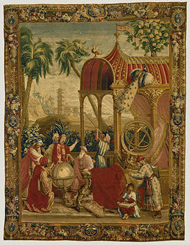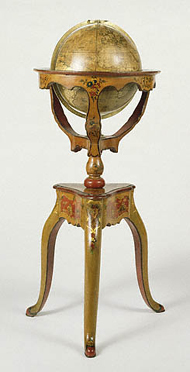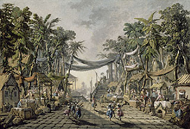|
Chinese and Japanese imports were wildly popular in Europe in the 1600s and 1700s. Every fashionable home was furnished with porcelain, lacquer, silk, and other materials previously little known in Europe. European artists and craftsmen combined eastern artistic forms and techniques from the Middle and Far East into a fanciful hybrid style known as chinoiserie, French for "Chinese-esque."
This exhibition explores 18th-century Europe's fascination with the Orient
and showcases works crafted in Europe and Asia that vividly demonstrate the exchange of arts and ideas between the East and West. The exhibition includes a rich array of paintings, prints, tapestries, costumes, textiles, illustrated books, porcelain, and furniture.
|
 |
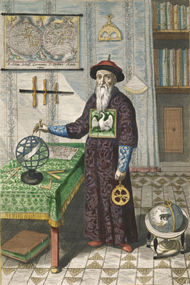
 |
 |
Father Schall von Bell, in China Monumentis, by Athanasius Kircher, 1668
|
 |
 |
|
|
 |
Missionaries and merchants were vital to the boom in trade and travel between Europe and the Far East in the 1600s.
The tapestry at the top of this page from The Story of the Emperor of China series depicts Jesuit priest and astronomy advisor Adam Schall von Bell with Chinese emperor Shunzhi. The tapestry is based on contemporary portraits of the two men. The fantastic background of trees and spires represents a European vision of China as a lush, exotic land.
Illustrated accounts by travelers to the Far East depicted some of the fabulous things they had seen. These volumes wowed Europeans with their illustrations of exotic Chinese plants, animals, costumes, landscapes, and architecture.
|
 |
|
The engraving above from Kircher's book is a portrait of Father Schall von Bell, who is also shown in the tapestry above. The depiction of his robes and hat are based on real 17th-century Chinese imperial garments.
European fascination with distant lands such as China and Japan resulted in greater interest in geography and navigation.
This globe, with its stand decorated with chinoiserie scenes in French imitation lacquer, was intended for a sumptuous noble interior. It illustrates the extent to which science had become fashionable in the 18th century.
|
 |
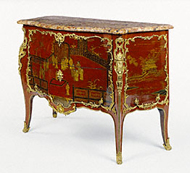
 |
 |
Commode
Bernard van Risenburgh, about 1740
|
 |
 |
|
|
 |
For centuries, European craftsmen attempted to imitate the styles and techniques of decorative art imported from the Middle and Far East. These craftsmen not only copied designs from imported objects, but also adapted these objects in creative ways.
Lacquer is a hard, shiny finish made from layers of tree sap. Lacquer furniture was imported from China and Japan, cut apart, and fitted back together on European furniture forms. The front of this French commode is covered with a thin layer of Chinese red lacquer. The rest of the piece is painted with French imitation lacquer known as vernis Martin after its inventors.
|
 |
 |
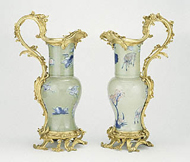
 |
 |
Pair of Ewers
Chinese porcelain with French mounts, about 1745–1749
|
 |
 |
|
Chinese and Japanese porcelain was a prized commodity in Europe. Porcelain was mounted in precious metals, depicted in paintings, and clustered on every conceivable surface. European manufacturers competed to find the recipe for true porcelain, a hard, white, heat-resistant ceramic unlike anything produced in Europe.
These Chinese vases were ornamented in Paris with gilt bronze mounts to adapt them into ewers for a fashionable French interior.
|
 |
|
French painter and designer Jean-Baptiste Pillement was a household name in 18th-century Europe. He specialized in charming character scenes and wildly inventive botanical motifs.
|
 |
 |
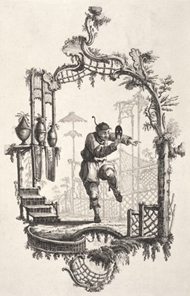
 |
 |
Dancing Figure Holding a Mask, from a series designed by Jean-Baptiste Pillement, 1759
|
 |
 |
|
 |
|
An imaginary semi-tropical port is the backdrop for the fanciful ballet scene shown above. The dancers and spectators represent people from many continents, celebrating an 18th-century notion of multiculturalism.
Prints of Pillement's designs, such as this one of a Chinese dancing figure, circulated widely throughout Europe. They were adapted for objects such as fans, dresses, curtains, upholstery, wallpaper, and porcelain.
From teapots and petticoats to paintings and tapestries, chinoiserie pervaded 18th-century taste.
The exhibition is located at the Getty Center, Museum, North Pavilion.
|
 |
